 Variant #1
Variant #1
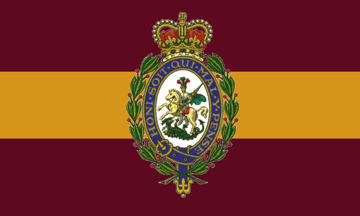 Variant #2
Variant #2
 Variant #3
Variant #3images by Pete Loeser, 29 January 2022

Last modified: 2022-02-05 by rob raeside
Keywords: united kingdom | army | regimental flags | keys: crossed | royal artillery |
Links: FOTW homepage |
search |
disclaimer and copyright |
write us |
mirrors
On this page:
'Regimental flags' (not to be confused with 'regimental colours') are roughly the equivalent of what the Canadians call a 'camp flag'. I have seen several examples, but I have never seen a comprehensive reference to these flags. As far as I can make out, they are post World War II innovations, have virtually no official status, and exist at regimental discretion. These flags are flown from poles, as opposed to colours/standards/guidons which are carried on parade.
 Variant #1
Variant #1
 Variant #2
Variant #2
 Variant #3
Variant #3
images by Pete Loeser, 29 January 2022
Royal Regiment of Fusiliers: St. George Cross with a central badge consisting of the regimental crest in proper colours (St. George and his dragon within a crowned Garter). The crest is often different from the cap badge - in this case the badge would be St. George on a flaming grenade.
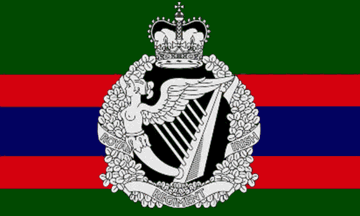 Variant #1
Variant #1
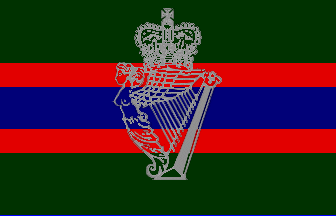 Variant #2
Variant #2
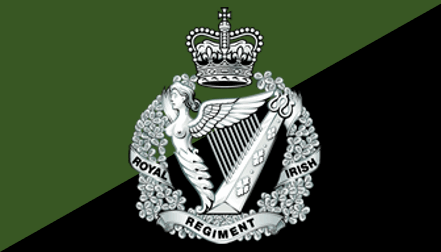 Variant #3
Variant #3
images #1 and #3 by Pete Loeser, 29 January 2022, Image #2 by Eugene Ipavec.
Royal Irish Regiment: a green flag with a thin horizontal blue stripe edged red (i.e. the red stripes are half the width of the blue), with the regimental badge (silver crowned Irish harp surrounded by wreath of clovers).
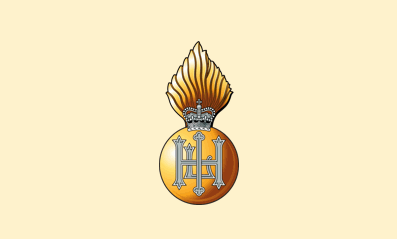 HLI Variant
HLI Variant
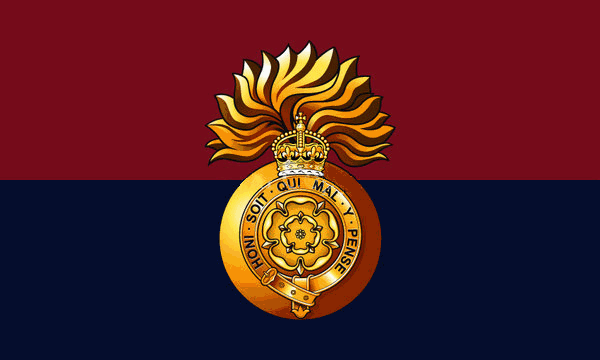 Variant #2
Variant #2
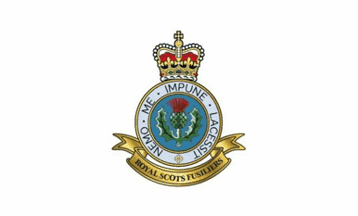 Colonels' Flag
Colonels' Flag
images by and located by Pete Loeser, 29 January 2022
Royal Highland Fusiliers: The regiment was formed in 1959 by amalgamation of the the Royal Scots Fusiliers and the Highland Light Infantry. The latter had two flags: (1) St. Andrew's cross, and (2) regimental monogram (HLI) and crown on a buff field. The former had three flags, and these were adopted by the new regiment due to their 'antiquity'. The 'Colonel's Flag' is white with a crowned thistle surrounded by the motto Nemo Me Impune Lacessit (motto of Scotland and the regiment). It is flown when the colonel is on parade. The 'Lieutenant Colonel's Flag' is a St. Andrew's Cross with a four-pointed white star superimposed. The points are wavy, extending into the blue quadrants almost to the edge of the flag. In the centre is the same crest as the Colonel's Flag. This is flown daily in barracks or camp. The 'Major's Flag' is identical to the Lieutenant Colonel's with the addition of a red pile wavy extending from the top left corner almost to the central badge. This is flown when command of the battalion devolves to the second in command, or when a major has an independent operational command of part of the regiment. These three flags are copies of the three senior colours in use prior to 1747 (every company had a colour). In that year regimental colours were limited to two per battalion, and their design became much more closely regulated.
T.F. Mills, 3 June 1998
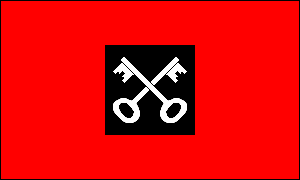 image by Tom Gregg
image by Tom Gregg
In past discussions it has been stated that there are no distinguishing flags for the divisions and brigades of the British Army. However, on the British Army web site, and I came upon the flag of the 2nd Division. It was shown in a photograph of the division's activation ceremony (April 2000). The flag displays the formation sign (shoulder sleeve insignia) of the division on a scarlet field. This formation sign dates from 1940; it was designed by the then-division commander, Major-General H.C. Lloyd. The crossed keys were taken from the arms of the Archbishop of York. The division is headquartered in Edinburgh and is responsible for command and control of Regular Army and Territorial Army units in the North of England and Scotland.
As the photograph on the website shows, the flag is not treated as a color (as are organizational flags of divisions in the US Army); it has no fringe and is being flown from an outdoor flag pole. I guess the correct nomenclature would be "camp flag," at least until we get more information.
So is this an official flag? Since it was used in an official military ceremony, I would assume that it is. Any additional information would be appreciated.
From the photograph it appears that height of the formation sign is half the hoist of the flag, and that overall proportions are 3:5, which is standard for the Union Jack as used by the Army.
Tom Gregg, 1 June 2001
The crossed keys
The crossed keys are explained in Howard Coles' "Formation Badges of WWII".
"... in the earliest days of the history of British arms, it was the practice in time of need for two armies to be raised, one in the south of England by the Archbishop of Canterbury, and the other in the north by the Archbishop of York. The northern army carried on its shield and banners the crossed keys (St Peter's Keys) taken from the arms of the Archbishop of York."
David Prothero, 2 June 2001
Flags like these are little more than camp colours. I have never managed to trace any regulations to cover them, except for an incidental mention in the minutes of the Army Dress Committee (which normally deals with uniforms).
I suspect that they are just bought out of unit funds as they are needed, and at the initiative of the commanding officer. We have one in the Flag Institute collection, co-incidentally it is also a 2 Division flag. The sheet is bunting, but the badge in the centre is nylon.
I have seen examples from the period of the Second World War, but the hey-day of these flags was in the 1950s and 1960s when unit signs proliferated, and the Army was so much bigger (before the end of conscription). It was usually simply a case of adding the unit badge to the distinguishing flag of a division, brigade, district or whatever, to mark the location of the unit's permanent HQ, or as a car flag. The latter range of flags are (or were) included in Queen's Regulations for the Army, though they provide for divisional commanders to have swallow-tailed, rather than rectangular, flags. It's certainly true that they are not honoured in the same fashion as regimental colours, partly I suspect because the assumed impermanent nature of the formation when compared to the regiment (this may be a purely British attitude).
Regiments, and some artillery batteries, also have their own unit flags, flown in a similar fashion. They are normally based around the colours of the regimental tie or stable belt, with either the regimental badge or unit badge in the centre. The earliest flag of this type I have seen is one for a battalion of the Royal Irish Rifles, dated somewhere between 1881 and 1902.
Ian Sumner, 4 June 2001
These semi-official flags may be making a bit of a comeback. I returned to the British Army site to browse around some more, and came upon this photograph of the raising of the 16 Air Assault Brigade flag. The 16 Air Assault Brigade was activated in 2000. The flag is a banner of the formation sign (which is shield-shaped) with the addition of the numeral "16" in the upper fly. Though it's hard to be certain from the photo, this flag looks more nearly square than the 2nd Division flag. Its colors--maroon and light blue--are those associated with the Parachute Regiment and the Army Air Corps respectively. The eagle is very similar to that of the Army Air Corps badge.
Tom Gregg, 4 June 2001
The British Army website contains some flag-like graphics that may depict real flags. An example is the Royal Artillery. The graphics depict corps badges on a field of the corps colors. Note that the badge is shown in proper colors. There are similar flag-like graphics for most of the other corps--the Adjutant General's Corps, the Army Air Corps, etc., etc. They look very similar to some of the Canadian "camp flags"
Tom Gregg, 4 June 2001
That is the flag of the Royal Artillery. Some individual units, e.g. 86 (Arracan) Battery and 4 Regiment use the device of the letters RA doubled and reversed, as at the right-hand side of the same page. There are glimpses of a number of RA unit flags at a flag manufacturer's website.
The badge of 16 Air Assault Brigade has prompted a lot of grumbling because it replaced the Pegasus badge that has been used since WW2. It is based on a WW2 badge used for a Training Centre in Scotland. As this is the only brigade with this badge, you have to wonder why they need the figure 16 as well. It makes a bit of a nonsense of having a distinctive badge.
I think the Canadian flags are in the British tradition. The colours used on the sheets of several of the Canadian corps are the same as the British equivalent. I think the same applies to other Commonwealth countries as well - the various Corps of Signals use light blue, dark blue and green for example.
Ian Sumner, 5 June 2001
See also: